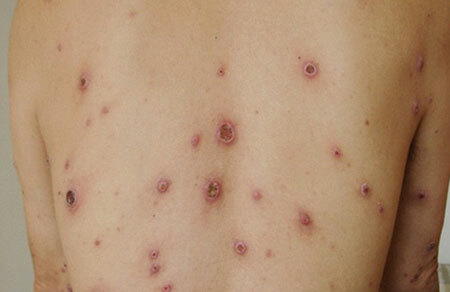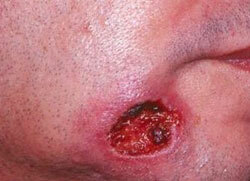STDs Syphilis belongs to a group of infectious diseases with predominantly sexual transmission. It is characterized by a chronic undulating course with a phased defeat of all organs and systems.
Classical syphilis includes 4 periods: incubation( 3-6 weeks), primary syphilis( 6-7 weeks), secondary forms of the disease( 2-4 years), tertiary period( many years from infection).
Contents
- 1 Symptoms and symptoms of syphilis infection
- 1.1 First signs of syphilis infection
- 1.2 Symptoms of secondary syphilis
- 1.3 Tertiary syphilis manifestations
- 2 Complications of the disease
- 3 Diagnosis of syphilis
- 4 Syphilis in pregnant women
- 5 Is it possible to give birth after syphilis?
- 6 Treatment of syphilis in women and men
Signs and symptoms of infection with syphilis
The disease causes pale treponema - a microbe of spiral shape, capable of active movement and well persistent in a moist external environment at room temperature.

The source of infection is a person who has symptoms of syphilis at any stage, while all biological fluids of the patient - saliva, blood, urine, semen - are dangerous.
The most frequent way of infection of women is to have sexual contact with a sick partner, but it is possible to get infected with kisses, general use of hygiene items, utensils and toiletries, while smoking one cigarette or hookah together.
A sick woman can infect her child in utero or while nursing him, while breastfeeding.
First signs of syphilis infection

First signs of syphilis
When syphilis infection in women, the first signs appear at the site of the introduction of treponema into the body: on the walls of the vagina, cervix, nipples, in the mouth or rectum there is a hard chancre that looks like a dense rounded ulcerous defectskin.
Shankr does not deliver any subjective discomfort( no pain, burning or wetting).Vaginal discharge in women with syphilis can become more dense, viscous, with the appearance of an unpleasant odor.
Sometimes lymph nodes may increase, the temperature of the body may increase slightly, general malaise may appear.
All these symptoms pass independently without treatment, but this can not be considered a recovery, it is the transition of the disease from primary to the next stage.
Symptoms of secondary syphilis
The secondary period of the disease is characterized by the cyclic appearance of syphilis( a variety of rashes in the form of spots, nodules, pustules) on the skin throughout the body and enlarged lymph nodes. The rash lasts for several weeks, then spontaneously goes away.
Episodes of eruptions for several years alternate with an asymptomatic stage.
A fresh process manifests itself as a bright, shallow, symmetrical, abundant rash without peeling. With relapse, syphilis are darker, larger, asymmetrical, prone to fusion with the formation of patterns on the skin, with signs of peeling at the edges.
Frequent signs of the second stage - the appearance of pigment syphilis in the form of a "necklace of Venus", after the disappearance of which remain white round spots. Eruptions in secondary syphilis contain a large number of active treponem, so during this period the patients are very contagious.
Tertiary syphilis manifestations

Approximately 4 years from infection, 40% of the cases develop signs of tertiary syphilis.
For this stage, the characteristic symptoms are syphilitic tubercles and nodes( gums) that are located in the deep layers of the skin and internal organs.
In its disintegration, gums are deformed tissues, form poorly healing ulcers and large stellate scars, worsening the work of organs.
Tertiary syphilis contain little treponem, so these patients are infectious to others.
Complications of the disease
Syphilitic infection without treatment has a perennial course and leads to destructive processes in different organs.
Neurosyphilis ends with paresis and paralysis, partial or complete loss of vision, damage to the membranes of the brain with the development of meningitis.
If the joints are damaged, there is a violation of the motor function of the limbs. Syphilis can form on all major vital internal organs, which leads to death.
Diagnosis of syphilis
For conducting a test for syphilis one should consult a doctor - gynecologists and dermatovenerologists know well how syphilis develops on the genitals, that's why the diagnosis is often possible at the stage of clinical examination.
Suspicious skin elements are scraped, which is then examined under a microscope in a dark field and sown to special media to determine the sensitivity of the microbe to antibiotics.
The most modern diagnostic method for is the PCR method, which allows to identify the disease at any stage, but it is not available in all medical institutions.
Therefore, the first place in the mass diagnosis of syphilis belongs to the detection of antibodies to syphilis in the blood( Wasserman-RW reaction), which becomes positive at 3-4 weeks from the onset of the disease.
Syphilis in pregnant women
For timely detection of syphilis in pregnant women, a three-time blood test for RW is provided: at 8-12, 30 and 38-40 weeks. Infection at any time of pregnancy is not considered an indication for interruption, but if an infection is detected, it is necessary to begin treatment as soon as possible.
The course of antibiotic therapy with the initial forms of syphilis in 1-2 trimester allows to completely prevent infection of the child.
The presence of a pregnant tertiary form or infection in the last trimester can not guarantee the safety of the fetus: even after successful treatment, such children should be under medical supervision in the early years of life to timely identify various manifestations of the congenital form of the disease.
Preparations for the treatment of syphilis in pregnant women can not be considered completely harmless, but their selection is based on the calculation of the lowest toxicity for the fetus( recommend cephalosporins and macrolides).
Without treatment, only 1 in 10 children from mothers with syphilis will be relatively healthy. The rest after the fourth month of intrauterine development there are symptoms of infection: there are changes in the liver, kidneys, bone system, mucous membranes.
Severe internal lesions result in fetal impotence, and this pregnancy results in late miscarriage or stillbirth.
Is it possible to give birth after syphilis?

Each specific situation should be considered separately, taking into account the form of the disease, the degree of severity, the amount of treatment performed, the duration of the process.
Ideally, a woman should come to the doctor-gynecologist at the conception stage, so that the doctor assesses all the characteristics of the organism and the disease transferred and decided whether it is possible for the patient to give birth to a healthy child after syphilis.
Statistics show that women successfully treated before pregnancy from primary and secondary syphilis give birth to fully healthy children.
After treatment of tertiary syphilis, several years must elapse before conception, while monitoring of the health condition is necessary to exclude the reactivation of the infection.
If you get good results for 3-4 years, doctors usually give a go-ahead for pregnancy, as there is no risk of infection of the fetus.
Treatment of syphilis in women and men
Early periods of the disease can be treated on an outpatient basis - within 1 month patients receive injections of bicillin( this is a long-acting penicillin antibiotic) several times a week.
Under steady-state conditions, the standard regimen for the treatment of syphilis( primary and secondary forms) includes intramuscular injections of penicillin 6 r / day for 14-28 days in combination with bicillin, antihistamines.
If local elements are present, treatment with antiseptic solutions is indicated.
For late or latent forms of the disease, first prepares with bismuth( biyohinol) preparations for 10-14 days, then penicillin therapy( at least 28 days) and preparations for maintenance of normal function of internal organs affected by pale treponema( hepatoprotectors,cardiotonics, nootropics).
The course of treatment for syphilis at any stage ends with the appointment of immunostimulants( retarpen, aloe, extencillin, splenin) to increase the body's own defenses.
After treatment, patients are under the control of doctors from 3-6 months.(with primary syphilis) to three years( with complicated forms).
Modern qualified syphilis therapy makes in most cases a prognosis for this disease is very favorable, so do not self-medicate and feel free to contact the doctors about the examination for this disease.

